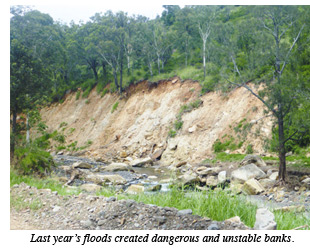|
Flood Recovery in South East Queensland
The 2011 devastating floods in Queensland impacted many landholders, including horse property owners. SEQ Catchments has been involved in helping landholders increase the natural resilience of their land to future flood impacts.
Flood waters can affect horse properties in various ways – horses can become injured by floating debris, the banks of creeks and rivers can become severely eroded and weeds transported downstream can often be poisonous to horses. Minimising these risks is a top priority for horse property owners, especially when their land is immediately bounded by creeks and riverbanks.
There are many things owners can do to help protect their horses during flood periods. Ensuring that horses have multiple exit points to higher ground, and can be moved quickly, is crucial and keeping ample food supplies available during flood periods will keep horses healthy and minimise their stress levels.
 The 2011 floods contributed to severe erosion throughout South East Queensland leaving dangerous, steep and unstable cliffs on the river banks. Where horses have free access to these banks, they can become injured and cause even further slumping of creek and river banks. Battering the banks back where heavy machinery is available and planting native vegetation can help stabilise these areas, but it is important to check with the regional Natural Resource Management (NRM) body, local government or government agency to determine if a permit is required to undertake such works. When repairing these banks it’s best to enlist the services of experienced soil experts, as each location can vary due to soil, vegetation and river flow conditions. The 2011 floods contributed to severe erosion throughout South East Queensland leaving dangerous, steep and unstable cliffs on the river banks. Where horses have free access to these banks, they can become injured and cause even further slumping of creek and river banks. Battering the banks back where heavy machinery is available and planting native vegetation can help stabilise these areas, but it is important to check with the regional Natural Resource Management (NRM) body, local government or government agency to determine if a permit is required to undertake such works. When repairing these banks it’s best to enlist the services of experienced soil experts, as each location can vary due to soil, vegetation and river flow conditions.
Where possible, fencing to exclude horses and other stock from entering the waterway will stop them making tracks that expose the soil and potentially erode the banks. In some cases, strategic grazing of riparian (local) vegetation is useful in reducing fire risk, although it is necessary to ensure that there are multiple exit points for the horses and that they are removed from the riparian areas during the flood or wet season.
The importance of riparian vegetation is also vital in helping stabilise river banks and rebuilding natural resilience. The root systems have an important role in holding the soil together and minimising erosion. It is always good to plant vegetation that is native to the area and the regional ecosystem concerned. Local NRM or Landcare groups may be able to suggest species, but generally it is recommended to plant hardy plants such as Lomandra at the base near the creek, shrubs in the middle and trees and shrubs at the top. Continuing to plant well back from the bank can protect the bank from future erosion and can also provide an important buffer zone between horses and the water course.
Often, logs, tree trunks and heavy rocks that are in the creek or river can be used to help strengthen the banks, deflect water away and protect banks from further erosion by strategic placement. Once again it is advisable to ask for expert advice in the placement of the tree trunks and rocks.
SEQ Catchments and the community has learnt much from this event and are keen to see better management of streams and flood plains, which can have a positive mitigating effect on floods in the future.
SEQ Catchments is a not-for-profit natural resource management body supporting landholders in South East Queensland. seqcatchments.com.au
|